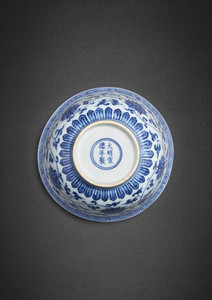明代筆記 vol.4 明宣德青花盌215.9萬港元成交,仇焱之舊藏 - An Edward T.Chow rare blue and white 'floral scroll' bowl, Mark and period of Xuande.
- SACA

- Apr 10, 2024
- 5 min read

finely potted with deep rounded sides rising from a slightly tapered foot to a flared rim, the exterior painted in shaded tones of cobalt-blue with characteristic 'heaping and piling' with five lotus blooms borne on a leafy scroll meandering around the bowl, all between bands of keyfret, stylised lotus lappets and classic scroll, the interior decorated with a matching medallion wreathed by a composite floral scroll around the cavetto and a foliate border below the inner rim, the base inscribed with a six-character reign mark within a double circle
17.5 cm
Estimate
800,000 - 1,200,000 HKD
Lot Sold
2,159,000 HKD
Property from an important European collection
A rare blue and white 'floral scroll' bowl,
Mark and period of Xuande
重要歐洲收藏
明宣德 青花纏枝花卉紋盌 《大明宣德年製》款
Provenance
Collection of Edward T. Chow (1910-80).
Acquired from Edward T. Chow (1910-80) in the late 1960s.
----------------------------------------------
仇焱之(1910-80年)收藏
1960年代末購自上述來源
Literature
Helen D. Ling and Edward T. Chow, Complete Collection of Ming Dynasty Kingtehchen Porcelain from the Hall of Disciplined Learning, vol. I, Hong Kong, 1950, pl. 49 (one of a pair, right bowl).
----------------------------------------------
Helen D. Ling 及仇焱之,《抗希齋珍藏歷代名瓷影譜》,卷1,香港,1950年,圖版49(一對之一,圖右)
Catalogue Note
Expertly painted on both the interior and exterior, this bowl epitomises the refinement of the early Ming aesthetic and embodies the ideals of harmony and precision. Its finely potted body, translucent glaze and delicate floral scroll that flows seamlessly around the vessel, are remarkable. Painting with cobalt on the cavetto was particularly difficult and the fine and vivid rendering of the floral scroll on this bowl testifies to the remarkable talent of the potters.
The form of this bowl and its delicate motif of lotus blooms appear to have enjoyed immediate success in the Yongle period and continued to be painted on imperial bowls through the succeeding reign. The remarkable technical and artistic advances made during the Xuande period are evident in the vividness and clarity of the design and consistent application of cobalt. The instability and fuzziness of the imported cobalt prevalent on the earlier Yongle wares demanded a revised formula of the pigment. With the inclusion of manganese native to China, the cobalt pigment used in the Xuande period enabled greater precision of the brushwork, which in turn conveyed a stronger sense of confidence on the part of the painter.
A devoted patron of the arts and himself a painter, the Xuande Emperor took a great interest in the production of porcelain at the Imperial kilns in Jingdezhen. Literary and archaeological evidence reveal an increased demand for imperial porcelain for both secular and religious use, resulting in the number of official kilns to increase from 32 to 58. Indeed the staggering number of shards unearthed from the Xuande stratum at the imperial kiln site in Zhushan, Jingdezhen, and the large collection of extant Xuande wares in the Qing Court collection and now in Beijing and Taipei, suggest a dramatic increase in production. Porcelain wares were made as gifts that signified imperial favour, but also for consumption at court and among members of the aristocracy. The Emperor himself reputedly ate three meals a day, each of which would have required a large number of utensils (Jessica Harrison-Hall, Ming Ceramics in the British Museum, London, 2001, p.119).
Bowls painted with this motif of lotus on the exterior and a composite floral scroll on the interior include one in the Palace Museum, Beijing, illustrated in Gugong Bowuyuan cang Ming chu qinghua ci [Early Ming blue-and-white porcelain in the Palace Museum], Beijing, 2002, vol. 2, pl. 148; another in the Palace Museum, Taipei, included in the Exhibition of Selected Hsüan-te Imperial Porcelains of the Ming Dynasty, Taipei, 1998, cat. no. 134; and a third in the Jingdezhen Ceramic Museum, Jingdezhen, illustrated in Keitokuchin jiki [Jingdezhen porcelain], Kyoto, 1982, pl. 40 (top). See also two in the British Museum, London, the first from the Sir Percival David collection, illustrated in R.L. Hobson, A Catalogue of Chinese Pottery and Porcelain in the Collection of Sir Percival David Bt., FSA, London, 1934, pl. CXXXIV (d), and the other from the collection of Mrs B.Z. Seligman, published in Jessica Harrison-Hall, op.cit., pl. 4:25; one in the Ashmolean Museum, Oxford, illustrated in Mary Tregear, Guide to Chinese Ceramics in the Ashmolean Museum, Oxford, 1966, p. 30; and another in the Indianapolis Museum included in the exhibition Blue and White: Chinese Porcelain and its Impact on the Western World, University of Chicago, Chicago, 1985, cat. no. 19. For a similar auction example, see one from the Tianminlou collection, sold in these rooms, 3rd April 2019, lot 10.
A slightly larger bowl of this pattern was excavated from the Yongle stratum at the site of the imperial kiln complex in Zhushan, Jingdezhen, and included in the exhibition Jingdezhen chutu Ming chu guanyao ciqi/Imperial Hongwu and Yongle Porcelain Excavated at Jingdezhen, Chang Foundation, Taipei, 1996, cat. no. 123.
Bowls of this design were treasured heirlooms, as attested by the depiction of ten bowls of this form and design in the handscroll of the imperial collection of the Yongzheng Emperor dated 1728. From the Moorhead and Sir Percival David collections, the scroll was sold in our London rooms, 19th May 1939, lot 62, and is now in the British Museum, London, published on the Museum’s website, accession no. PDF X01, 16th view.
----------------------------------------------
此盌內外兼飾,畫功卓絕,足見明初至臻和諧之美。器形精緻,釉色澄明,纏枝蓮紋優雅流暢,誠經典佳例。盌內弧壁繪飾頗難,此盌紋樣細膩生動,非能工巧匠不能為也。
此盌之器形紋飾,永樂年間已享盛譽,而後多有承襲。至宣德一朝工藝尤甚精進,本盌紋樣逼真靈動,青花發色豔麗均勻,乃宣德佳作。永樂青花多以舶來鈷料製色,發色極難掌控,且紋飾常顯渾散模糊,故製色之法有待改良。宣德之鈷藍則添國產錳料製色,發色清晰,紋飾筆觸細膩,更見工匠之精湛畫功。
北京故宮藏一青花纏枝蓮紋盌例,與本盌相類,內壁飾花卉紋,外壁飾纏枝蓮紋,錄於《明初青花瓷》,北京,2002年,圖版148。台北故宮亦藏一例,見於《明代宣德官窰菁華特展圖錄》,台北,2008年,編號134。第三例藏景德鎮中國陶瓷博物館,刊於《景徳鎮磁器》,京都,1982年,圖版40(上)。大英博物館亦見兩例,其一為大維德爵士收藏,載於霍蒲孫,《A Catalogue of Chinese Pottery and Porcelain in the Collection of Sir Percival David Bt., FSA》,倫敦,1934年,圖版 CXXXIV (d),其二為 B.Z. Seligman 夫人收藏,錄於霍吉淑,《大英博物館藏中國明代陶瓷》,倫敦,2001年,圖版4:25。英國阿什莫林博物館也藏一例,見於陶美,《Guide to Chinese Ceramics in the Ashmolean Museum》,牛津,1966年,頁30。美國印弟安納波里斯藝術博物館藏盌,則見錄於《Blue and White: Chinese Porcelain and its Impact on the Western World》,芝加哥大學,芝加哥,1985年,編號19。拍賣類例可參見天民樓舊藏,售於香港蘇富比2019年4月3日,編號10。
景德鎮珠山御窰廠窰址永樂地層出土一相類紋飾但盌徑稍大之例,展於《景德鎮出土明初官窰瓷器》,鴻禧美術館,台北,1996年,編號123。
此類青花纏枝蓮紋盌歷代均為罕珍極品,世代相傳。成於清雍正六年(1728年)之〈古玩圖〉軸,繪纏枝蓮紋十盌疊置,可見一斑。此卷曾為 Moorhead 及大維德爵士收藏,後售於倫敦蘇富比1939年5月19日,編號62,現藏倫敦大英博物館,載於博物館官方網站,藏品編號 PDF X01,第16面。
Condition The mouth has an approx. 3.5 cm hairline, adjacent to another Y-shaped one (approx. 0.8 cm from rim). Otherwise overall good condition.
----------------------------------------------
口沿一處約3.5公分沖線,另一Y形沖線約0.8公分。
HK

























Comments